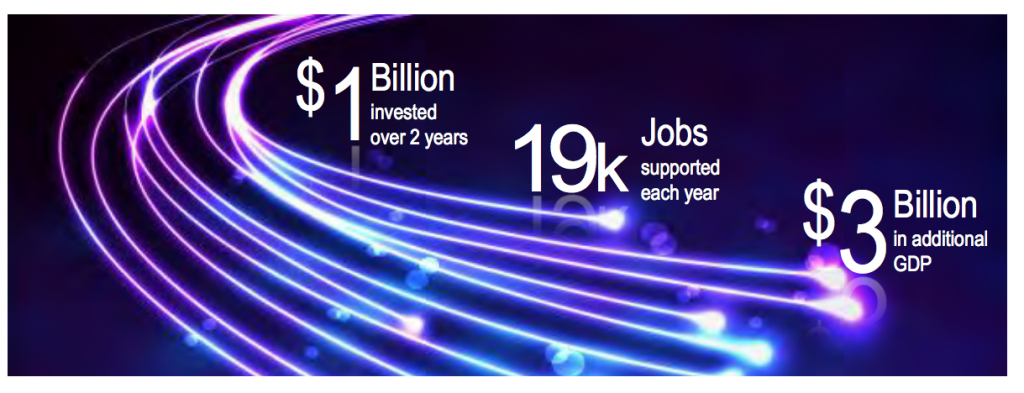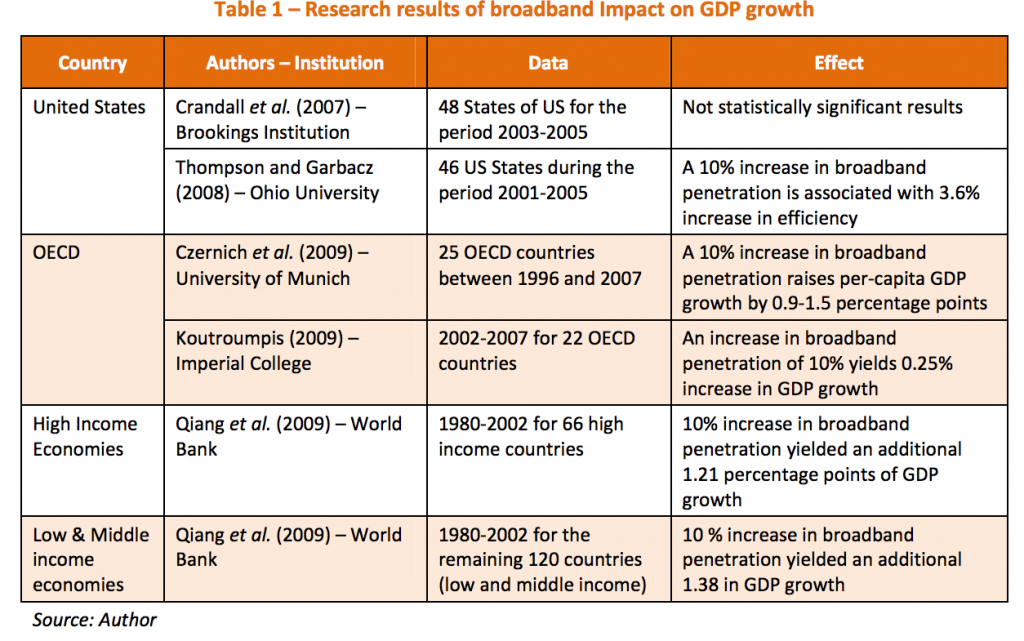Michel Surprenant, le Maire de Chertsey, avait fait des études préliminaires pour couvrir de fibre optique notre localité. Pour les 300 km² de notre ville, il en couterait $8millions.
Si nous extrapolons ce calcul à la province, en considérant que celle-ci compte 110 000 km² de territoire habité (selon Chaire pour le développement de la recherche sur la culture d’expression française en Amérique du Nord (CEFAN) [2]) avec une simple règle de trois, on obtient un beau $2,9 milliards pour couvrir le Québec habité en entier.
Or, au moment d’écrire ces lignes, la CDP est prête à investir $5,5 milliards pour son réseau électrique métropolitain. Dans le site web dédié à cette initiative, elle présente que pour un investissement de $5,5 milliards, il y aura des retombés de $3 milliards, sur une période de 4 ans [3].
Les retombées potentielles de ce réseau représentent plus de 3 milliards de dollars sur quatre ans pour le PIB québécois. En ce qui concerne les développements immobiliers le long du tracé, près de 5 milliards de dollars en investissements privés sont actuellement anticipés. Près de 7 500 emplois directs et indirects seront également générés durant chacune des quatre années de construction de ce nouveau réseau. Plus de 1 000 emplois permanents seront générés à la suite de sa mise en service.
L’économiste Hal Singer (financé par Bell Canada) dans son document Economic Impact of FTTH Deployment in Toronto [4], présente que pour un investissement de $1 milliard dans la fibre optique à Toronto, il prévoit la création de 19 000 emplois et des retombés de $3 milliards pour ce même PIB, mais sur une période de 2 ans.
Pourtant, j’imagine que la CDP est au fait des publications du Forum Économique Mondial, de même que de l’International Telecommunication union (ITU)? Or, selon le Forum Économique Mondial
Based on a significant body of research1 on the economic impact of broadband, it is generally accepted that broadband has a beneficial impact on economic growth. Moreover, some research suggests that broadband speed matters. The impact of broadband includes (1) direct effects through large-scale infrastructure investments that lead to increased economic activity in the investment area (e.g. immediate increase in employment and purchase of raw material), (2) indirect- or long-term effects that spur innovation and productivity through e.g. improved broadband speeds, and (3) induced effects such as spill-over into other economic sectors by enabling access to entertainment, education, healthcare, banking services, e-commerce and other. The benefits of faster broadband include economic effects such as increased innovation and productivity, social effects such as better access to services and improved healthcare and environmental effects such as more efficient energy consumption.
et
Studies of the impact of broadband on the economy have generated a number of elasticity estimates for a 10% increase in broadband penetration. These estimates refer to different geographic regions and country clusters. The range proposed by these studies for the impact on GDP of a 10% increase in broadband penetration is 0.25%- 1.38%. For broadband speed, it has been found that a doubling of broadband speeds for an economy can add 0.3% to GDP growth.6 These different elasticities are set out in Table 1 below. It should be noted that results indicate that the impact on GDP from an increase in penetration and also speed is higher for lower-income countries, as compared with higher income countries. However, results also show that a critical mass of penetration is needed to achieve these positive effects.
Quant à elle, l’ITU présente que
The study of the impact of broadband on economic growth covers numerous aspects, ranging from its aggregate impact on GDP growth, to the differential impact of broadband by industrial sector, the increase of exports, and changes in intermediate demand and import substitution. While the research on the contribution of broadband to GDP growth has confirmed its positive impact, it has also yielded results that vary widely. Constrained by data availability, the analyses have primarily focused on OECD countries (generally Western Europe and North America) and states in the United States (see Table 1).
As the data in Table 1 indicates, most studies conclude that broadband penetration has an impact on GDP growth. However, one observes that such a contribution appears to vary widely, from 0.25 to 1.38 per cent for every increase in 10 per cent of penetration
Quoi qu’il en soit, il m’apparaît évident que les retombées économiques trébuchantes de la mise en place de la fibre optique à la grandeur du Québec risquent clairement d’être plus rentables que dispendieuses. Et cela autant au bénéfice de la Caisse de dépôt et placement du Québec, ou du gouvernement lui-même, que pour la santé de notre produit intérieur brut.
D’ailleurs, si on investissait dans la fibre optique, nous n’aurions probablement plus besoin de ce réseau électrique métropolitain et les bénéfices de ces investissements rejailliraient sur le Québec tout entier plutôt que strictement à la région métropolitaine de Montréal…


